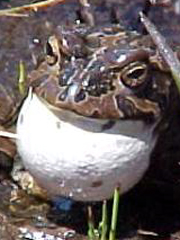|
YOSEMITE TOAD } Bufo canorus

|
RANGE: The central Sierra Nevada of California, from Alpine County to Fresno County
STATUS: Named Imperiled by NatureServe but still waiting for protection under the U.S. Endangered Species Act
THREATS: Introduced fish, pesticides and other airborne chemical pollutants, increased ultraviolet radiation from ozone depletion, cattle grazing, pathogens, and drought
Robust and stocky with dry, uniformly warty skin, the Yosemite toad has a call far more delicate than its appearance: a long, rapid musical trill often mistaken for bird song. During the spring breeding season, male toads assemble around shallow pools of water to call to females en masse, their activities peaking at mid-day. Outside mating season, the toads are solitary creatures, spending most of the year hibernating under the Sierra Nevada’s deep snow. Once the most common high-elevation Sierra amphibians, Yosemite toads have declined dramatically, especially in their namesake Yosemite National Park. The Center for Biological Diversity petitioned the U.S. Fish and Wildlife Service to protect the species under the Endangered Species Act, but so far the agency has only made the Yosemite toad a “candidate” for protection.
LEARN MORE ABOUT THE YOSEMITE TOAD
|